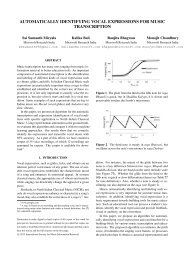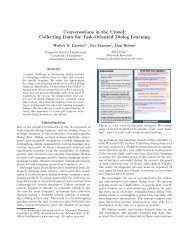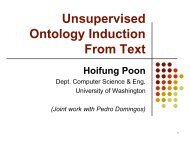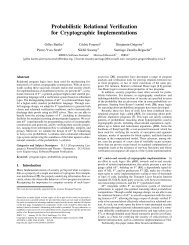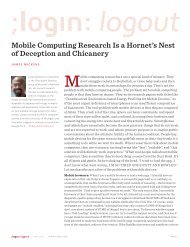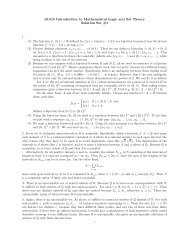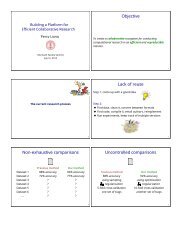On Intuitionistic Linear Logic - Microsoft Research
On Intuitionistic Linear Logic - Microsoft Research
On Intuitionistic Linear Logic - Microsoft Research
You also want an ePaper? Increase the reach of your titles
YUMPU automatically turns print PDFs into web optimized ePapers that Google loves.
§2. Natural Deduction 33<br />
(We have introduced a shorthand notation in the last two cases, where Weakening ∗ and Contraction ∗<br />
represent multiple applications of the Weakening and Contraction rule respectively.) The process<br />
above gives rise to a relation which we shall denote by ❀β. We shall describe one of the steps as<br />
a β-reduction rule and say that a deduction is β-reducible if we can apply one of the β-reduction<br />
rules.<br />
Definition 6. A deduction D is said to be in β-normal form if it is not β-reducible.<br />
2.2 Subformula Property and Commuting Conversions<br />
We have already considered the subformula property in §1.3, in the context of the sequent calculus<br />
formulation. Whereas in that case the property held simply by inspection of the derivation rules,<br />
things are more delicate in the natural deduction formulation. For example, consider a deduction<br />
which ends with an application of the −◦E rule<br />
·<br />
A−◦B<br />
· D1<br />
B<br />
· D2<br />
A<br />
(−◦E).<br />
Even if the deduction is in β-normal form, it is not simply the case by inspection that the subformula<br />
property holds, i.e. that A−◦B is a subformula of Γ or ∆ (it is certainly not a subformula of B!).<br />
We also note that for most of the elimination rules the conclusion is not a subformula of its major<br />
premise. 8 These rules are (⊗E), (IE), (⊕E), (fE), Weakening and Contraction; which we shall refer<br />
to collectively as bad eliminations, with those remaining being known as good eliminations.<br />
We shall introduce the notion of a path through a deduction. The idea is that we trace downwards<br />
through a deduction from an assumption, with the hope that each trace yields a path with the<br />
property that the every formula is a subformula of either an open assumption or of the final formula<br />
in the path. Our notion of a path is based on Prawitz’s treatment of IL [62], although he attributes<br />
the idea to Martin-Löf.<br />
Definition 7. A path in a β-normal deduction, D, is a sequence of formulae, A0, . . .,An, such that<br />
1. A0 is an open assumption or axiom; and<br />
2. Ai+1 follows Ai if<br />
(a) Ai+1 is the conclusion of an introduction rule (excluding (tI)) and Ai is a premise of the<br />
rule (if the rule is Promotion, then Ai must not be a minor premise); or<br />
(b) Ai+1 is the conclusion of an elimination rule and Ai is either the major premise of a good<br />
elimination rule, or the minor premise of a bad elimination rule (excluding (fE)); or<br />
(c) Ai is the major premise of a bad elimination rule (excluding (fE)) and Ai+1 is an assumption<br />
discharged by that application; or<br />
(d) Ai is the minor premise of an application of the Promotion rule and Ai+1 is the corresponding<br />
assumption discharged by that assumption; and<br />
3. An is either the conclusion of D, or the major premise of (IE) or Weakening, or a premise of<br />
(fE).<br />
We shall identify a particular path as mentioned earlier.<br />
Definition 8. A subformula path is a path in a deduction, D, such that every formula in it is either<br />
a subformula of an assumption or of the final formula in the path.<br />
Consider a β-normal deduction, D, of the form<br />
8 Girard [34] calls such conclusions parasitic formulae.



